Description
Female Short Nose Seahorses, Hippocampus hippocampus, also go by the name Short Snouted Seahorse. These fish make are great options for marine tanks and are fun to keep. As the name suggests, their snout is short and upturned, and less than one third the length of the head. Short Nose Seahorses can be: brown, orange, purple or black in colour.
Seahorses get their name from their elegant, elongated snout and curved neck which resembles a horse. In fact, their genus Etymology is “horse” (hippos) and “sea monster” (kámpos)
Seahorse, pipefish and sea dragons all belong to the Syngnathidae family. These ray finned fish have an unusual body plan. For instance, Female Short Nose Seahorses swim vertically in the water, rather than horizontally. An adaptation thought to help them to hide in seagrasses. Seahorses use their dorsal fin for forward motion, while other ray finned fish use their tail and caudal fin. Instead of a caudal fin, Seahorses have a flexible tail they use for grasping.
Female Short Nose or Short Snouted Seahorses Ecology:
Short Nose Seahorses naturally occur in the Eastern Atlantic and Mediterranean. They occur around the British Isles, the Azores and Canary Islands. They also live in the Gulf of Guinea and along the African coast.
In the wild, Female Short Nose Seahorses live in a wide variety of habitats, usually coastally. They mimic the colour of the vegetation they hide in, taking on green or yellow hues. Short Nose Seahorse can be found living in complex and sparse environments, amongst rock and algae.
Arguably, seahorses are most famous for their unusual reproduction. Courtship can include dances and colour changes depending on the species. Short Nose Seahorses do change colour. The female will deposit her eggs into a brood pouch on the males ventral side. He will then fertilize them and carry them for a time.
Hippocampus hippocampus in the Aquarium:
It is important to have plenty of nooks or crannies where your Female Short Nose Seahorse can anchor itself and feel at home.
Seahorses do best when fed a varied diet. Here they are eating frozen Mysis, frozen brineshrimp, frozen copepods, ocean nutrition fish eggs. We enrich all our frozen food with seachem garlic guard and Atvitol vitamins. These are imperative for keeping fish healthy by providing them with the nutrition otherwise lost in frozen food. In doing so, these additives support their immune system and increase longevity.
In addition, Female Short Nose Seahorses will also eat live foods, such as copepods and amphipods, that can be cultivated in attached refugium. Our seahorses are adapted to aquarium life before being offered for sale. Meaning they are eating frozen food when they leave us.
You can keep Short Nose Seahorses in pairs or groups. They are not the strongest of swimmers so flow rate needs to be not too much for them. Feel free to give us a call for advice on a seahorse set up. On account of their slow movement, keepers may wish to use a feeder.
The Fish pictured here are representative only and the livestock you receive may vary in pattern, coloration, and shape.








